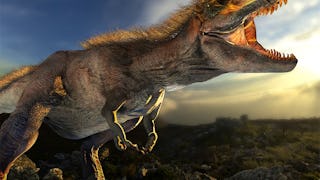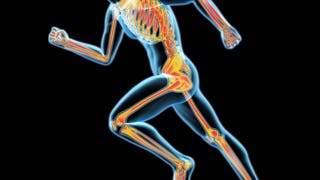Paleontology: Early Vertebrate Evolution is a four-lesson course teaching a comprehensive overview of the origin of vertebrates. Students will explore the diversity of Palaeozoic lineages within a phylogenetic and evolutionary framework. This course examines the evolution of major vertebrate novelties including the origin of fins, jaws, and tetrapod limbs. Students also explore key Canadian fossil localities, including the Burgess Shale (British Columbia), Miguasha (Quebec), and Man On The Hill (Northwest Territories). Watch a preview of the course here: https://uofa.ualberta.ca/courses/paleontology-vertebrate-evolution

Enjoy unlimited growth with a year of Coursera Plus for $199 (regularly $399). Save now.

Paleontology: Early Vertebrate Evolution

Instructor: Alison Murray, Ph.D
28,930 already enrolled
Included with
(1,184 reviews)
Skills you'll gain
Details to know

Add to your LinkedIn profile
4 assignments
See how employees at top companies are mastering in-demand skills

There are 4 modules in this course
In this lesson we take you back to the beginning of the Phanerozoic Eon to learn what it truly means to have backbone, as we encounter the key anatomical features of vertebrates and their closest chordate relatives. We’ll also introduce the language of evolution – phylogenetics – as we examine some of the contenders for the title of ‘The Earliest Vertebrate’, and give you a crash course in sedimentology, so you can begin to piece together the spectacular environments that were home to our early aquatic ancestors. Just a quick note before you get started: 'Palaios' is the Greek word for 'ancient', so palaeontology or paleontology is the study of ancient life. Both spellings are correct, with palaeontology used in Britain, and paleontology more common in the US.
What's included
4 videos6 readings1 assignment
The old problem of the comparative anatomist was exactly how to compare two animals that appeared, at first glance, to look nothing alike. How, do you compare cows and lobsters? Well, in this lesson you’ll not only learn how to compare crustaceans and cattle, but you’ll also quickly learn that there’s more to a vertebrate than just a backbone as we delve into basic vertebrate anatomy. We’ll cover all the need-to-know anatomical terms and directions, as well as specialist features like the lateral line system, which not only helped early fish avoid predation, but is also the main reason why you find it very difficult to catch fish with your bare hands today! We will also explore the immense diversity of the jawless vertebrates including the tenacious Cyclostomata, the elusive Conodonta, and, long before Ankylosaurus, a group of heavily armoured jawless fishes – the ostracoderms.
What's included
3 videos1 reading1 assignment
The Ordovician, Silurian and Devonian Periods were times of great continental, oceanic and climactic change that brought about the Earth’s first mass extinction events. With environmental catastrophes opening up new ecological niches, a trait evolved in early vertebrates that would prove so successful that over 99% of modern vertebrates still retain it: jaws. In this lesson we will try to understand the geographical and temporal background of early vertebrate diversity, as well as the impact and origin of the evolution of jaws on vertebrate life. Introducing huge predators such as Dunkleosteus along the way, we’ll explore the incredible diversity of the Gnathostoma (the jawed fishes), mainly from fossils known from the spectacular Late Devonian site of Miguasha in Quebec. So get ready for a lesson you can really sink your teeth into!
What's included
3 videos1 reading1 assignment
Although this lesson marks the end of the beginning of the vertebrate story, we still have some bones left to pick! In this last lesson we’ll look at the features of the Osteichthyes (the bony fishes) and examine the differences between two immensely successful vertebrate groups; one that conquered the water: the Actinopterygii (ray-finned fishes), and one that eventually conquered the land: the Sarcopterygii (lobe-finned fishes). We’ll investigate how the sarcopterygians gave rise to the tetrapods, meet our very first tetrapod ancestors like Acanthostega, and introduce the features that were essential in making the leap from water to land. Along the way we’ll meet some living fossils, see some incredible evolutionary adaptations, and learn about our earliest terrestrial origins – it’s time to step up and finish the tale of ‘Early Vertebrate Evolution’!
What's included
3 videos1 reading1 assignment
Instructor

Offered by
Explore more from Basic Science
 Status: Preview
Status: PreviewUniversity of Alberta
 Status: Preview
Status: PreviewUniversity of Alberta
 Status: Preview
Status: PreviewAmerican Museum of Natural History
 Status: Free Trial
Status: Free TrialDartmouth College
Why people choose Coursera for their career




Learner reviews
1,184 reviews
- 5 stars
86.83%
- 4 stars
11.64%
- 3 stars
1.26%
- 2 stars
0.08%
- 1 star
0.16%
Showing 3 of 1184
Reviewed on Jul 8, 2016
I haven't completed this course yet. Self pace and enjoying the lectures and videos. I've taken another Univ of Alberta course on Marine Reptiles which was great! I enjoy the Paleontol
Reviewed on Apr 20, 2019
Short but amazing view on fish development with lots of technical terminologies. The very enjoyable way of learning. Thank you for this course and the whole series!
Reviewed on Mar 21, 2020
the course was very interesting even for a 13 year old like me I wold like to encourage more people to do this course and will certainly tell my friends about it

Open new doors with Coursera Plus
Unlimited access to 10,000+ world-class courses, hands-on projects, and job-ready certificate programs - all included in your subscription
Advance your career with an online degree
Earn a degree from world-class universities - 100% online
Join over 3,400 global companies that choose Coursera for Business
Upskill your employees to excel in the digital economy
Frequently asked questions
To access the course materials, assignments and to earn a Certificate, you will need to purchase the Certificate experience when you enroll in a course. You can try a Free Trial instead, or apply for Financial Aid. The course may offer 'Full Course, No Certificate' instead. This option lets you see all course materials, submit required assessments, and get a final grade. This also means that you will not be able to purchase a Certificate experience.
When you purchase a Certificate you get access to all course materials, including graded assignments. Upon completing the course, your electronic Certificate will be added to your Accomplishments page - from there, you can print your Certificate or add it to your LinkedIn profile.
Yes. In select learning programs, you can apply for financial aid or a scholarship if you can’t afford the enrollment fee. If fin aid or scholarship is available for your learning program selection, you’ll find a link to apply on the description page.
More questions
Financial aid available,

